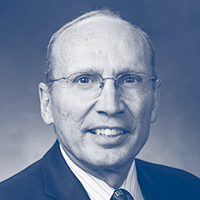
Congress shall make no law respecting an establishment of religion, or prohibiting the free exercise thereof; or abridging the freedom of speech, or of the press; or the right of the people peaceably to assemble, and to petition the Government for a redress of grievances.

Guy Anderson Chair and Professor of Law at the J. Reuben Clark Law School at Brigham Young University

Richard and Frances Mallery Professor and Director of the Constitutional Law Center at Stanford Law School; Senior Fellow at the Hoover Institution
Many settlers from Europe braved the hardships of immigration to the American colonies to escape religious persecution in their home countries and to secure the freedom to worship according to their own conscience and conviction. Although the colonists often understood freedom of religion more narrowly than we do today, support for protection of some conception of religious freedom was broad and deep. By the time of Independence and the construction of a new Constitution, freedom of religion was among the most widely recognized “inalienable rights,” protected in some fashion by state bills of rights and judicial decisions. James Madison, for example, the principal author of the First Amendment, eloquently expressed his support for such a provision in Virginia: “It is the duty of every man to render to the Creator such homage, and such only, as he believes to be acceptable to him. This duty is precedent both in order of time and degree of obligation, to the claims of Civil Society.”
Although the original Constitution contained only a prohibition of religious tests for federal office (Article VI, Clause 3), the Free Exercise Clause was added as part of the First Amendment in 1791. In drafting the Clause, Congress considered several formulations, but ultimately settled on protecting the “free exercise of religion.” This phrase makes plain the protection of actions as well as beliefs, but only those in some way connected to religion.
From the beginning, courts in the United States have struggled to find a balance between the religious liberty of believers, who often claim the right to be excused or “exempted” from laws that interfere with their religious practices, and the interests of society reflected in those very laws. Early state court decisions went both ways on this central question.
The Supreme Court first addressed the question in a series of cases involving nineteenth-century laws aimed at suppressing the practice of polygamy by members of the Church of Jesus Christ of Latter-day Saints (LDS), also known as Mormons. The Court unanimously rejected free exercise challenges to these laws, holding that the Free Exercise Clause protects beliefs but not conduct. “Laws are made for the government of actions, and while they cannot interfere with mere religious belief and opinions, they may with practices.” Reynolds v. United States (1878). What followed was perhaps the most extreme government assault on religious freedom in American history. Hundreds of church leaders were jailed, rank-and-file Mormons were deprived of their right to vote, and Congress dissolved the LDS Church and expropriated most of its property, until the church finally agreed to abandon polygamy.
The belief-action distinction ignored the Free Exercise Clause’s obvious protection of religious practice, but spoke to the concern that allowing believers to disobey laws that bind everyone else would undermine the value of a government of laws applied to all. Doing so, Reynolds warned, “would be to make the professed doctrines of religious belief superior to the law of the land, and in effect to permit every citizen to become a law unto himself.”
Reynolds influenced the meaning of the Free Exercise Clause well into the twentieth century. In 1940, for example, the Court extended the Clause—which by its terms constrains only the federal government—to limit state laws and other state actions that burden religious exercise. Cantwell v. Connecticut (1940). Though it recognized that governments may not “unduly infringe” religious exercise, the Court reiterated that “[c]onduct remains subject to regulation for the protection of society,” citing Reynolds as authority. Similarly, the Court held in 1961 that the Free Exercise Clause did not exempt an orthodox Jewish merchant from Sunday closing laws, again citing Reynolds.
In the 1960s and early 1970s, the Court shifted, strengthening protection for religious conduct by construing the Free Exercise Clause to protect a right of religious believers to exemption from generally applicable laws which burden religious exercise. The Court held that the government may not enforce even a religiously-neutral law that applies generally to all or most of society unless the public interest in enforcement is “compelling.” Wisconsin v. Yoder (1972). Yoder thus held that Amish families could not be punished for refusing to send their children to school beyond the age of 14.
Although the language of this “compelling-interest” test suggested powerful protections for religion, these were never fully realized. The cases in which the Supreme Court denied exemptions outnumbered those in which it granted them. Aside from Yoder, the Court exempted believers from “availability for work” requirements, which denied unemployment benefits to workers terminated for prioritizing religious practices over job requirements. But it denied exemptions to believers and religious organizations which found their religious practices burdened by conditions for federal tax exemption, military uniform regulations, federal minimum wage laws, state prison regulations, state sales taxes, federal administration of public lands, and mandatory taxation and other requirements of the Social Security system. In all of these cases the Court found, often controversially, either that the government’s interest in enforcement was compelling, or that the law in question did not constitute a legally-recognizable burden on religious practice.
In 1990, the Supreme Court changed course yet again, holding that the Free Exercise Clause “does not relieve an individual of the obligation to comply with a valid and neutral law of general applicability on the ground that the law proscribes (or prescribes) conduct that his religion prescribes (or proscribes).” Employment Division v. Smith (1990). Though it did not return to the belief-action distinction, the Court echoed Reynolds’ concern that religious exemptions permit a person, “by virtue of his beliefs, to become a law unto himself,” contradicting “both constitutional tradition and common sense.” Any exceptions to religiously-neutral and generally-applicable laws, therefore, must come from the “political process.” Smith went on to hold that the Free Exercise Clause does not protect the sacramental use of peyote, a hallucinogenic drug, by members of the Native American Church.
Smith proved to be controversial. In 1993, overwhelming majorities in Congress voted to reinstate the pre-Smith compelling-interest test by statute with the Religious Freedom Restoration Act (RFRA). RFRA authorizes courts to exempt a person from any law that imposes a substantial burden on sincere religious beliefs or actions, unless the government can show that the law is the “least restrictive means” of furthering a “compelling governmental interest.” Almost half of the states have passed similar laws—“state RFRAs”—applicable to their own laws. In 1997 the Supreme Court held that Congress had constitutional authority only to apply RFRA to federal laws, and not to state or local laws. Congress then enacted a narrower law, the Religious Land Use and Institutionalized Persons Act (RLUIPA), which applies the compelling-interest test to state laws affecting prisoners and land use. RFRA and RLUIPA have afforded exemptions in a wide range of federal and state contexts—from kosher and halal diets for prisoners, to relief from zoning and landmark regulations on churches and ministries, to exemptions from jury service.
Although some exemption claims brought under these religious freedom statutes have been relatively uncontroversial—the Supreme Court unanimously protected the right of a tiny religious sect to use a hallucinogenic drug prohibited by federal law and the right of a Muslim prisoner to wear a half-inch beard prohibited by state prison rules—some touch on highly contested moral questions. For example, the Court by a 5-4 vote excused a commercial family-owned corporation from complying with the “contraception mandate,” a regulation which required the corporation’s health insurance plan to cover what its owners believe are abortion-inducing drugs. Burwell v. Hobby Lobby Stores Inc. (2014). In the wake of Hobby Lobby and the Court’s subsequent determination that states may not deny gays and lesbians the right to civil marriage, state RFRAs have become a flashpoint in conflicts over whether commercial vendors with religious objections may refuse their products and services to same-sex weddings.
Besides RFRA and other exemption statutes, the Free Exercise Clause itself, even after Smith, continues to provide protection for believers against burdens on religious exercise from laws that target religious practices, or that disadvantage religion in discretionary, case-by-case decision making. In Church of the Lukumi Babalu Aye, Inc. v. City of Hialeah (1993), for example, the Court unanimously struck down a local ordinance against the “unnecessary” killing of animals in a “ritual or ceremony”—a law that was drawn to apply only to a small and unpopular religious sect whose worship includes animal sacrifice.
The Court recently recognized that the Free Exercise Clause (along with the Establishment Clause) required a religious exemption from a neutral and general federal antidiscrimination law that interfered with a church’s freedom to select its own ministers. The Court distinguished Smith on the ground that it “involved government regulation of only outward physical acts,” while this case “concerns government interference with an internal church decision that affects the faith and mission of the church itself.” Hosanna-Tabor Evangelical Lutheran Church & School v. E.E.O.C. (2012).
It remains unclear whether Lukumi and Hosanna-Tabor are narrow exceptions to Smith’s general presumption against religious exemptions, or foreshadow yet another shift towards a more exemption-friendly free exercise doctrine.